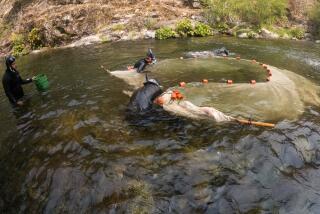Salmon Sex Changes Worry Researchers
- Share via
SEATTLE — Four-fifths of the female salmon spawning in the last free-flowing reach of the Columbia River apparently began life as males, raising troubling new questions about the survival of the Pacific Northwest’s signature fish species.
In a study that could provide ammunition in the battle over the massive hydropower dams that traverse the Columbia and Snake rivers, researchers at the University of Idaho and Washington State University found significant sex reversals in the fall Chinook salmon that spawn on the Columbia’s Hanford Reach in central Washington.
The research is unsettling because salmon runs in the Hanford Reach--where the Columbia passes relatively unbridled through the vast Hanford nuclear reservation--are the healthiest in a region where many are on the brink of collapse.
The cause of the embryonic gender shift is unknown, but there are suspects. Environmental estrogens are one possibility. They are the chemical byproducts, potentially traceable to pesticides and industrial runoff, that have been linked to issues such as early puberty and infant mortality in humans.
The other potential factor is the hydropower dams, which produce temperature fluctuations in the river of the kind known to cause gender modifications in fish.
If that is the case, it could add fuel to the debate over breaching dams in the West to save the region’s disappearing salmon runs. The Clinton administration is scheduled to release its final recommendations on that issue Thursday.
One obvious culprit--radiation seeping from the Hanford reservation--has been discounted. The amount of radioactivity known to be going into the river is too small to have produced such changes, the study’s authors said.
Researchers cautioned that it is too early to draw any conclusions from the findings, which examined salmon in a single year and did not look at the effects of the gender shifts on the overall salmon population.
“I think maybe what this points out is there’s a whole lot we don’t know or understand right now,” said Gary Thorgaard, biology professor at Washington State and coauthor of the study.
Thorgaard and University of Idaho zoology professor James Nagler said, however, that there may be worrisome implications if the gender-altered fish produce generations of “super males” that skew the population too heavily toward males.
“Unfortunately, I can’t put this in a positive light,” Nagler said. “But we can’t really say anything relative to whether this could be a major factor” in the decline of salmon populations.
Using a genetic test developed by British Columbian fisheries scientist Bob Devlin, who previously has documented gender shifts in fish, the salmon researchers were able to identify chromosomes in the fish after they had spawned and died.
“We have found that a majority of the female Chinook salmon sampled carry a genetic marker that is found only in male salmon. The best explanation for these results is that these females have been sex reversed and are in fact male,” Nagler said.
There were no similar reversals in hatchery salmon that spawned near the Hanford Reach but originally had been hatched in well water--indicating that whatever caused the phenomenon probably occurred in the river water while the fish were developing in their eggs or shortly after hatching.
“These results may explain in part the difficulties some salmon have had reproducing in the Columbia River basin,” Nagler said.
Fish have the same chromosomal sex composition as any other species: Females have two X chromosomes and males have an X and a Y. The sex of the offspring is determined by what male sperm fertilizes an egg. But the salmon researchers found that 80% of the females they studied--females that had clearly produced eggs and spawned--had at least one Y chromosome, identical to males.
While normal females will produce nothing but X-chromosome eggs, leaving male fish to determine the sex of the offspring, the sex-reversed females will produce half X eggs and half Y eggs. Y eggs that are fertilized by Y-chromosome sperm will produce a YY-chromosome “super male” fish whose characteristics in the wild are completely unknown.
Indeed, this may already have happened, the researchers conceded.
“Whether this kind of fish is viable, that’s a big question,” Nagler said. “But if they do survive and they were to return in appreciable numbers to spawn, the scenario is we would have an increase in the number of males in the population because all the offspring of this fish would be male.”
Over a period of years, this could skew the fish population so far that reproduction rates would fall, the researchers said.
YY male fish have been produced in the laboratory, but there is no way of identifying them in the wild unless they are captured and bred.
The study, published in the January issue of Environmental Health Perspectives, is “one of the first insights that basic problems in fish production and genetics could be a significant factor affecting the decline of salmon populations,” said Michael Skinner, director of the Center for Reproductive Biology at Washington State and the University of Idaho.
But Washington state officials said the study, if it flags the presence of harmful chemicals in the Columbia, could mean as much for humans as for fish. “The results are interesting. They point to some sort of environmental problem we may need to deal with,” said Craig Busack, conservation biologist for the state Department of Fish and Wildlife. “But it’s not clear to me this really poses a hazard to the viability of the fish run.”
More to Read
Sign up for Essential California
The most important California stories and recommendations in your inbox every morning.
You may occasionally receive promotional content from the Los Angeles Times.













